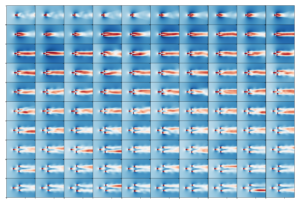Authors
Shuvayan Brahmachary, Postdoctoral research fellow, Technical University of Munich
Nils Thuerey, Associate Professor, Technical University of Munich
Abstract
This work delineates a hybrid predictive framework configured as a coarse-grained surrogate for reconstructing unsteady fluid flows around multiple cylinders of diverse configurations. The presence of cylinders of arbitrary nature causes abrupt changes in the local flow profile while globally exhibiting a wide spectrum of dynamical wakes fluctuating in either a periodic or chaotic manner. Consequently, the focal point of the present study is to establish predictive frameworks that accurately reconstruct the overall fluid velocity flowfield such that the local boundary layer profile, as well as the wake dynamics, are both preserved for long time horizons. The hybrid framework is realized using a base differentiable flow solver combined with a neural network, yielding a differentiable physics-assisted neural network (DPNN). The framework is trained using bodies with arbitrary shapes, and then it is tested and further assessed on out-of-distribution samples. Our results indicate that the neural network acts as a forcing function to correct the local boundary layer profile while also remarkably improving the dissipative nature of the flowfields. It is found that the DPNN framework clearly outperforms the supervised learning approach while respecting the reduced feature space dynamics. The model predictions for arbitrary bodies indicate that the Strouhal number distribution with respect to spacing ratio exhibits similar patterns with existing literature. In addition, our model predictions also enable us to discover similar wake categories for flow past arbitrary bodies. For the chaotic wakes, the present approach predicts the chaotic switch in gap flows up to the mid-time range.
Keywords
Differentiable physics, cylinder wakes, arbitrary bodies, interpretable predictions, residual networks
Motivation
The work aims at enabling a hybrid predictive framework that can yield faithful reconstruction of spatio-temporal fluid properties representing periodic, quasi-periodic or chaotic wake flows. The underlying merits of such a framework can be derived from the need to render accurate predictions on a coarse grid, which are known to induce greater numerical dissipation thereby causing significant deviations from the ground-truth solutions. Moreover, the masked stair-step representation of the underlying body boundary by the base solver for numerical efficiency causes inaccurate local boundary layer profile. The central goal of the work thus aims at leveraging differentiable physics assisted by neural networks to accurately learn the local boundary layer profile while also faithfully predicting the unsteady vortex shedding dynamics.
Datsets

The present work comprises 100 experiments each consisting of 3000 frames of velocity fields at different spacing ratio with diverse configurations immersed in it. The figure above displays the mean velocity flowfield that are arranged in increasing spacing ratio, descriptive of different kinds of wake flows.
Interpretable predictions

We determine the interpretability of the data obtained form the predictive framework by comparing the scalar predictions (e.g., Strouhal number St) obtained by long time integration of velocity flowfields with existing literature Chen et al. 2020, as shown above.

